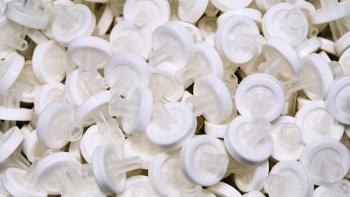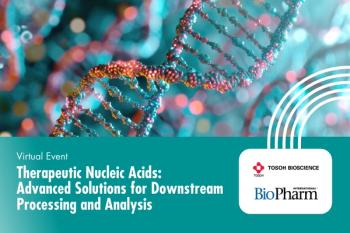
- BioPharm International-06-02-2006
- Volume 2006 Supplement
- Issue 3
Filtration Designs Remove Processing Bottlenecks for High-Yield Biotech Drugs
Biotech companies are running into production bottlenecks because standard purification and separation technologies lack the capability to remove the elevated levels of biomass from high titer solutions. Recent developments in filter technology offer the biotech industry a cost-effective solution to processing challenges by reducing bottlenecks, thereby accelerating the time-to-market of new drugs.
Biotech companies are running into production bottlenecks because standard purification and separation technologies lack the capability to remove the elevated levels of biomass from high titer solutions. Recent developments in filter technology offer the biotech industry a cost-effective solution to processing challenges by reducing bottlenecks, thereby accelerating the time-to-market of new drugs.
This article focuses on new designs of sterilizing-grade filters that remove bacteria, toxins, and other contaminants from initial purification steps to final formulation and filling. We discuss these important parameters in filter selection: materials, compatibility, wettability, sterilization, adsorption, and membrane and filter construction.
Materials and Compatibility
Three hydrophilic sterilizing-grade membrane materials are readily available: Nylon 6,6, polyvinylidene fluoride (PVDF), and polyether sulfone (PES). Table 1 summarizes the general compatibilities for each membrane type. PES and PVDF are low binding, water wettable and can be gamma irradiated. The membrane with the broadest pH compatibility is PES.
Table 1. General compatibility of polymers for filtration
Wettability
The ability to wet a filter completely is important, because the objective is to use the full filtration area. If a significant portion of the membrane is not wetted properly, then the filtration flow can be impaired. In addition, it is necessary to have a fully wetted membrane during the performance of an integrity test. If the filter membrane is not completely wetted, then even a very small non-wetted area of the filter could cause a failure of the integrity test, causing process delays and re-testing.
In terms of wettability of membrane material, Nylon 6,6 is the most easily wetted because it is naturally hydrophilic. PVDF is naturally hydrophobic, and for liquid applications will under go some sort of modification to make the membrane hydrophilic. This version is close to Nylon 6,6 in terms of wettability. Most common PES filters do not wet easily and usually require backpressure to wet completely, making integrity testing more difficult and time consuming. However, recent improvements in PES wetting chemistry have rendered its wettability comparable to PVDF membrane filters.
Sterilization
Integrated single-use bioprocess systems incorporating filters, tubing, and bags can play a key role in helping companies to increase manufacturing capacity. A single-use capsule does not require cleaning or cleaning validation because it can be pre-sterilized via gamma irradiation by the manufacturer. This simplifies process operations because pre-sterilized filters do not require assembly or steam sterilization. The housing material used in capsule filters is also often polypropylene. For capsules that will be sterilized by gamma irradiation, the polypropylene must be gamma stable to ensure structural strength, compatibility, and low extractables.
Figure 1. This diagram depicts an asymmetric membrane with a 3:1 gradient in average pore size
Adsorption
The purpose of filtration is to remove a particular contaminant or groups of contaminants from the process feed. The filter system should not be adding anything significant (extractables) to the process fluid, nor should it remove a desired product component from the fluid that is being filtered.
In some cases, where low concentrations of proteins or preservatives are in the fluid, there may be a loss in product yield if the filter membrane adsorbs significant amonts of product . At high component concentrations this is not a concern, but this is especially critical where a desired component is present in very low concentration. The effluent should be tested to ensure that the amount of loss is acceptable.
Table 2. IgG Transmission
Here is a test run example. IgG protein transmission was measured to demonstrate differences in protein adsorption among membrane types. Each disc was challenged with 60 mL protein solution at 100 μg/mL concentration. Filtrate was collected in 1 mL aliquots for the first 10 mL followed by 5 mL aliquots to a total throughput of 60 mL. Data in Table 2 indicate that protein binding occurs within the first 10 mL passed through each membrane disc. After the first 10 mL, the effluent contains protein at the same concentration as the influent solution. PES and PVDF are generally low adsorptive materials. However, nylon bound 20 times more protein than PES in the first 10 mL. Extrapolating to production scale; this may affect product yield.
Table 3. Area per 10-inch cartridge
Lifetime is a Function of Construction
New filter designs have faster flow rates, smaller filter systems, improved microorganism and particle retention, and longer service life. These benefits translate into significant cost and time savings for drug manufacturers. Advances in the speed, size, and performance of new generation membrane filters are perhaps most critical because membrane technology is used in a broad range of applications. Lifetime (throughput) and flowrate at process scale are highly influenced by the structure of the membrane.
When flowrate is the main driver, new high-flow sterilizing-grade filters feature a serial layer construction where the upstream layer is an asymmetric, high porosity PES membrane over the final sterilizing-grade layer. This PES filter offers exceptionally high flows at a processing rate of 17 L/min at 100-mbar differential pressure (916;P), and is compatible with fluids across a wide pH range, from buffers to numerous biological fluids.
Figure 2. Cross section of high-area asymmetric filter cartridge showing retained contaminant
When lifetime is the main driver, a high-capacity sterilizing-grade filter offers users an innovative hybrid technology by fitting a finer grade of asymmetric PES membrane over a PVDF membrane. This membrane combination enables high dirt-holding capacities and the flexibility for either wet or dry steaming. Because autoclaving or steam-in-place procedures can take place in either wet or dry conditions, this flexibility accommodates different manufacturing specifications. The high-capacity hybrid filter offers competitive flow rates at 10 L/min at 100-mbar ΔP; in addition it offers the high throughput required in the filtration of high protein biotech solutions.
Figure 3. Upstream side of prefilter final filter layers showing clean membrane due to effective prefiltration
Asymmetric Prefilter Construction Improves Capacity
A technology that has contributed significantly to the performance of new generation membrane filters is an asymmetric membrane structure that offers a 3 to 1 average pore size gradient through the depth of the membrane, resulting in higher porosity and dirt holding capacity. This pore size gradient (Figure 1) enables larger particles to be captured in the outer portion of the filter, while the sterilizing layer provides high efficiency removal of smaller microorganisms.
Figure 4. A unique folding pattern in a new filter design increases filter area
Whereas traditional membrane constructions have a homogeneous pore size distribution across the membrane, the asymmetric structure with its large void volume is able to capture solids across the entire depth and pore gradient of the membrane, improving total filter capacity. (Figures 2 and 3).
Table 4. Cartridge construction affects flowrates
Deep Pleat Design Maximizes Throughput
Minimizing system size while maintaining process flow and volume has required unique approaches. One of these is modifying the traditional pleat pack design. In order to achieve greater filter surface area, while keeping the same cartridge configuration the traditional fan pleat filter has been replaced with a deep pleat design (Figure 4). This deep pleating technology is used to form a very robust filter pack that allows up to 50% greater filtration area than traditional fan pleat and improved flow distribution in the membrane cartridge. Table 3 shows the benefits of deep pleat design in that there is more area in the PES and hybrid filters compared to traditionally pleated nylon and PVDF filters.
Table 5. Test of filtering 100 L of vaccine
Another factor employed to increase pleat length is a reduction in the size of the core-collecting chamber. This allows the flow path to extend into the space that would normally be reserved for the core, enabling much greater membrane flow and fluid throughput (Figure 5).
The core chamber's materials of construction also influence the integrity and usability of the filter. The combination of a narrow polypropylene core and deep pleat design enhance mechanical stability and robustness during operation and steam sterilization. The strength of the design means that a higher differential pressure (1 bar vs. 300 mbar for most fan pleated filters) can be safely reached during steam in place operation without damaging the filter. This means that a 10-in. filter can be used to achieve the flow rates of a conventional 20-in. filter. For example, a sterilizing-grade deep-pleat filter with 1 m2 membrane can achieve flow rates of greater than 17 L/min. A traditional 10-in. filter with the same removal efficiency might only provide flow rates of 3 to 7 L/min. Figure 6 shows results of a test. By increasing flowrate capability of single filter elements, the deep pleat design also allows biopharmaceutical companies to reduce the number and size of filter assemblies.
Table 6. Test of 550 L MAb batch
Applications
Buffer Filtration
Filterability studies were performed using model buffer solutions to determine the optimum membrane for large-scale buffer filtration applications. For solutions with low solids levels such as clean buffer solutions, results are best described in terms of flowrate per 10-in. cartridge per hour, at a given pressure, rather than volume processed to point of plugging. Table 4 shows that the high-flow PES membrane demonstrated flow rates 3 to 5 times greater than the nylon membrane and 3 to 4 times greater than the PVDF membrane. Based on the results, PES membrane demonstrated superior flow characteristics during filtration. This is our membrane choice for buffer filtration applications.
Figure 5. Two types of cores
Vaccines
To filter a batch of 100 L of vaccine product a total of six traditional nylon filters would be used. The same batch can be filtered with one deep pleated PES filter (Table 5). The deep pleat design and asymmetric pore structure allows end users to reduce the number and size of filter assemblies. Smaller filter assemblies mean fewer components to sterilize, test, clean, and validate.
Figure 6. Water flowrates per 10-inch cartridge
Monoclonal Antibodies
To process a 550 L batch of monoclonal product, two high-flow PES filters are required. The same batch can be filtered with one high-capacity hybrid filter (Table 6).
As these examples have shown, however a manufacturer chooses to realize the benefits of innovative filter technology, the end result is more efficient and faster processing of lifesaving drugs.
Quick Recap
MONICA CARDONA is a marketing manager with Western Hemisphere responsibility for direct flow filtration with Pall Corporation, 516.801.9526, fax 516.801.9548,
OLIVER G. INSEAL is an R&D mechanical engineer at Pall Corporation Life Sciences Department, +44.23.9230.3300, Oliver G.
Articles in this issue
over 19 years ago
The Renaissance of Protein Purificationover 19 years ago
Chromatography Process Development Using 96-Well Microplate FormatsNewsletter
Stay at the forefront of biopharmaceutical innovation—subscribe to BioPharm International for expert insights on drug development, manufacturing, compliance, and more.




